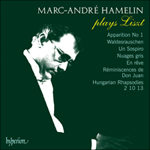Along with the early
Harmonies poétiques et religieuses and the first book of the
Album d’un voyageur,
Apparitions stake Liszt’s earliest claim to be regarded as a mature and original musical thinker—he was 22 years old at the time of their composition. Although it is quite clear that only a very few of his contemporaries had the slightest understanding of his intentions, and generally preferred his early studies and transcriptions, it is these other extraordinarily avant garde works which forced the doubters to reconsider, and which, along with the re-examination of the late pieces, led to the re-appraisal of Liszt in the middle of the twentieth century. The first piece has a rhythmic flexibility which often suspends the perceived metre altogether, and the theme in thirds with tremolo accompaniment is one of Liszt’s most compelling. The second is uneasily torn between being carefree and poignant, again the character led by the unusual rhythm, and the third is almost like a composer under some hallucinogenic drug, dreaming of a Schubert waltz—a unique contribution to the literature, and quite unlike the later use of the same waltz in the
Soirées de Vienne.
from notes by Leslie Howard © 1994
Accompagnant les
Harmonies poétiques et religieuses des premiers temps et le premier livre de l’
Album d’un Voyageur,
Apparitions. représentent la première prétention de Liszt à se faire reconnaître comme un penseur musical original et mûr: il avait 22 ans à l’époque où il les composa. Quoique, de toute évidence, très peu de ses contemporains comprenaient tant soit peu ses intentions, et préféraient généralement ses études antérieures et ses transcriptions, ce sont ces autres œuvres, tout à fait d’avant-garde, qui forcèrent les douteurs à se raviser, et qui, avec le réexamen des œuvres tardives, conduisit à une nouvelle appréciation de Liszt au milieu du vingtième siècle. Le premier morceau possède une flexibilité rythmique qui suspend souvent entièrement le mètre tel qu’on le perçoit, et le thème en tierces avec un accompagnement en trémolo est l’un des plus irrésistibles de Liszt. Le second thème hésite entre l’insouciant et le poignant, mené là encore par un rythme inhabituel, et le troisième semble presque sorti du crâne d’un compositeur qui aurait pris une drogue hallucinogène, et qui rêverait à une valse de Schubert—une contribution musicale exceptionnelle dans son genre, fort différente de ce que Liszt tirera de la même valse dans les
Soirées de Vienne.
extrait des notes rédigées par Leslie Howard © 1994
Français: Luisella Simpson
Neben den früheren
Harmonies poétiques et religieuses und dem ersten Buch des
Album d’un Voyageur untermauert
Apparitions. Liszts frühesten Anspruch, als ein reifer und origineller musikalischer Denker verstanden zu werden—er schrieb die Stücke im Alter von 22 Jahren. Obwohl eindeutig feststeht, daß nur wenige seiner Zeitgenossen seine Intentionen auch nur im entferntesten verstanden und im allgemeinen seine frühen Studien und Transkriptionen bevorzugten, sind es eben diese außergewöhnlich avantgardistischen Werke, die die Zweifler dazu gezwungen haben, neue Schlüsse zu ziehen, und die in Verbindung mit der erneuten Untersuchung der späten Stücke zu einer Neueinschätzung Listzs in der Mitte des zwanzigsten Jahrhunderts geführt haben.
Das erste Stück besitzt eine rhythmische Flexibilität, die das Taktmaß häufig völlig untergräbt, und das in Terzen gehaltene Thema mit begleitendem Tremolo ist eines der faszinierendsten von Liszts Themen.
Das zweite Stück pendelt unentschieden zwischen Sorglosigkeit und schneidender Schärfe hin und her und zeichnet sich in seinem Charakter wiederum durch den ungewöhnlichen Rhythmus aus. Das dritte wirkt fast so, als stehe der Komponist unter dem Einfluß einer zu Halluzinationen führenden Droge und träume von einem Schubertwalzer—ein einzigartiger Beitrag zu der Musikliteratur und ganz anders in seiner Wirkung als die spätere Version des Walzers in Soirées de Vienne.
aus dem Begleittext von Leslie Howard © 1994
Deutsch: Hypérion


 Liszt: Complete Piano Music
Liszt: Complete Piano Music Liszt: Marc-André Hamelin plays Liszt
Liszt: Marc-André Hamelin plays Liszt
